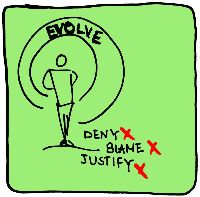
Let’s Do Something About It.
Any environment where people work together and rely on each other requires it, and positional and influential leaders are pivotal to it. TRUST, however, is at thing that seem to elude many teams. Many team members struggle to voice their opinions, feel connected to the work, colleagues or management. Corridor conversations are rampant and morale is low. Innovative and explorative work is lacking, as the workplace is seen as being fraught with danger and there are no safety nets in place for people to take risks.
The frontiers of brain research continue to add gravitas to what self aware leaders have instinctively known - when there are high levels of trust in a team there are far higher levels of collaboration; exploration; problem solving – not to mention happiness!
Brain imaging has shown clear indication that when we trust, we flood the more evolved prefrontal cortex – executive brain - with feel good chemicals such as oxytocin and dopamine. When this part of the brain is firing, it is responsible for growth, learning, connection, strategic thinking and problem solving. We feel safe to be vulnerable, expose our thinking and test our assumptions. When we distrust, the chemistry that closes down this part of the brain switches on, causing us to be in uncertainty, and on our way to a fear state – driven by the amygdala. Different thinking and patterns are going on for us, a completely different set of neural networks at play.
When we are sitting in distrust, the chemicals flooding the brain, such as cortisol and norepinephrine are more likely to induce negative thoughts, aggressive (or passive-aggressive) behavior and survival mentality. We tend to jump to conclusions that are not of a positive nature and ‘bunker-down’ our thinking. We no longer feel safe and code people as ‘foe’ rather than ‘friend’.
Individuals – both leaders and team members I work with see trust as paramount to being able to deal with the complexity of the work and take approaches to the next level, yet many are unsure of how to get themselves out of a state of distrust in the first place. ( If I distrust you, why should I get you to trust ME?) We get caught in a cycle of this distrust, unwilling to be vulnerable and ‘make the move’. We are also being held to ransom by our more primitive brain where the amygdala resides, stressed, anxious and fearful ourselves.
Small steps. It doesn’t have to be hard to start the shift. Simply begin working with others in a way that honors you and them. Move away from ‘I’ thinking to ‘we’ thinking and start recoding those neural pathways from distrust to trust.
Here are five simple suggestions for how you can increase the trust with people in your teams as well as flood your own brain with the right kinds of chemistry!

1. Discover - Ask questions to discover more about what your people think about things and how they see the world. Talk with genuine curiosity with people to find out their opinions.

2. Appreciate - Notice and talk with your colleagues about what you appreciate about them.

3. Admit - Admit when you’re wrong – and how you’ve learnt or are learning from it.

4. Evolve - Get rid of blame and justification language when you speak with others – taking responsibility for your actions and approaches.

5. Align - Do what you say you will do.
Judith Glaser’s book “Conversational Intelligence’ How Great Leaders Build Trust and Get Extraordinary Results’ is a rich source for leaders wanting to increase their knowledge of how to use conversations to bring about transformation in their teams, backed by a solid research base in the science of the brain. Her approach to trust is to build it through authentic and trust inducing actions through conversations.
Tracey Ezard works with organisations and leaders to gain momentum. Get ahead of the wave through engagement, collaboration and action. To talk with Tracey about her innovative approaches to bringing leaders and teams into space of collaboration through leadership, learning and strategy, email tracey@traceyezard.com
Tracey’s book ‘The Buzz’ Creating A Thriving and Collaborative Staff Learning Culture, writing for education leaders is out April 2015.